标签:android style blog http color os 使用 io strong
什么是Fragment:
Android是在Android 3.0 (API level 11)开始引入Fragment的。
可以把Fragment想成Activity中的模块,这个模块有自己的布局,有自己的生命周期,单独处理自己的输入,在Activity运行的时候可以加载或者移除Fragment模块。
可以把Fragment设计成可以在多个Activity中复用的模块。
当开发的应用程序同时适用于平板电脑和手机时,可以利用Fragment实现灵活的布局,改善用户体验。
Fragment的意义:
Android在3.0中引入了fragments的概念,主要目的是用在大屏幕设备上--例如平板电脑上,支持更加动态和灵活的UI设计。平板电脑的屏幕要比手机的大得多,有更多的空间来放更多的UI组件,并且这些组件之间会产生更多的交互。Fragment允许这样的一种设计,而不需要你亲自来管理 viewhierarchy的复杂变化。 通过将activity的布局分散到fragment中, 你可以在运行时修改activity的外观,并在由activity管理的back stack中保存那些变化.
例如, 一个新闻应用可以在屏幕左侧使用一个fragment来展示一个文章的列表,然后在屏幕右侧使用另一个fragment来展示一篇文章--2个fragment并排显示在相同的一个activity中,并且每一个fragment拥有它自己的一套生命周期回调方法,并且处理它们自己的用户输入事件。 因此, 取代使用一个activity来选择一篇文章而另一个activity来阅读文章的方式,用户可以在同一个activity中选择一篇文章并且阅读, 如图所示:
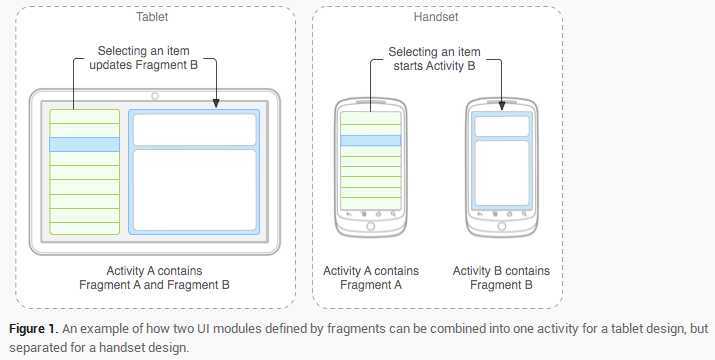
fragment在你的应用中应当是一个模块化和可重用的组件.即,因为fragment定义了它自己的布局, 以及通过使用它自己的生命周期回调方法定义了它自己的行为,你可以将fragment包含到多个activity中. 这点特别重要, 因为这允许你将你的用户体验适配到不同的屏幕尺寸.举个例子,你可能会仅当在屏幕尺寸足够大时,在一个activity中包含多个fragment,并且,当不属于这种情况时,会启动另一个单独的,使用不同fragment的activity.
继续之前那个新闻的例子 -- 当运行在一个特别大的屏幕时(例如平板电脑),应用可以在Activity A中嵌入2个fragment。然而,在一个正常尺寸的屏幕(例如手机)上,没有足够的空间同时供2个fragment用, 因此, Activity A会仅包含文章列表的fragment, 而当用户选择一篇文章时, 它会启动ActivityB,它包含阅读文章的fragment.因此, 应用可以同时支持上图中的2种设计模式。
Fragment的生命周期:
因为Fragment必须嵌入在Acitivity中使用,所以Fragment的生命周期和它所在的Activity是密切相关的。
如果Activity是暂停状态,其中所有的Fragment都是暂停状态;如果Activity是stopped状态,这个Activity中所有的Fragment都不能被启动;如果Activity被销毁,那么它其中的所有Fragment都会被销毁。(对Activity不熟悉的话,请看另一篇文章《Android四大组件之Activity》)
但是,当Activity在活动状态,可以独立控制Fragment的状态,比如加上或者移除Fragment。
当这样进行fragment transaction(转换)的时候,可以把fragment放入Activity的back stack中,这样用户就可以进行返回操作。
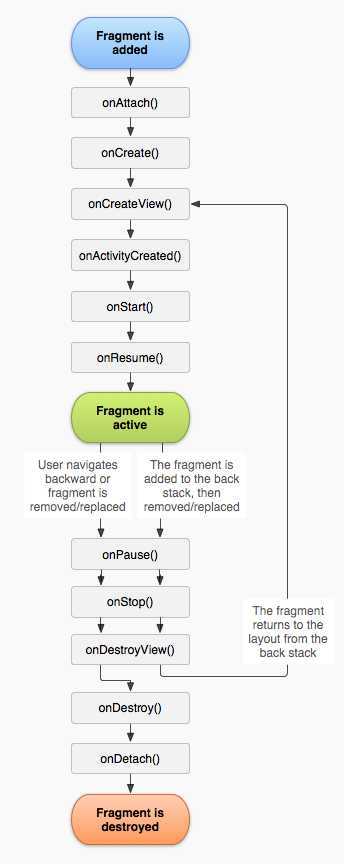
Fragment的使用:
通常, 应当至少实现如下的生命周期方法:
大多数应用应当为每一个fragment实现至少这3个方法,但是还有一些其他回调方法你也应当用来去处理fragment生命周期的各种阶段.全部的生命周期回调方法将会在后面章节 Handlingthe Fragment Lifecycle 中讨论.
除了继承基类 Fragment , 还有一些子类你可能会继承:
实现Fragment的UI
提供Fragment的UI,必须实现onCreateView()方法。
假设Fragment的布局设置写在example_fragment.xml资源文件中,那么onCreateView()方法可以如下写:
public static class ExampleFragment extends Fragment { @Override public View onCreateView(LayoutInflater inflater, ViewGroup container, Bundle savedInstanceState) { // Inflate the layout for this fragment return inflater.inflate(R.layout.example_fragment, container, false); } }
onCreateView()中container参数代表该Fragment在Activity中的父控件;savedInstanceState提供了上一个实例的数据。
inflate()方法的三个参数:
第一个是resource ID,指明了当前的Fragment对应的资源文件;
第二个参数是父容器控件;
第三个布尔值参数表明是否连接该布局和其父容器控件,在这里的情况设置为false,因为系统已经插入了这个布局到父控件,设置为true将会产生多余的一个View Group。
当Fragment被加入Activity中时,它会处在对应的View Group中。
Fragment有两种加载方式:一种是在Activity的layout中使用标签<fragment>声明;另一种方法是在代码中把它加入到一个指定的ViewGroup中。
另外,Fragment它可以并不是Activity布局中的任何一部分,它可以是一个不可见的部分。这部分内容先略过。
加载方式1:通过Activity的布局文件将Fragment加入Activity
在Activity的布局文件中,将Fragment作为一个子标签加入即可。
如:
<?xml version="1.0" encoding="utf-8"?> <LinearLayout xmlns:android="http://schemas.android.com/apk/res/android" android:orientation="horizontal" android:layout_width="match_parent" android:layout_height="match_parent"> <fragment android:name="com.example.news.ArticleListFragment" android:id="@+id/list" android:layout_weight="1" android:layout_width="0dp" android:layout_height="match_parent" /> <fragment android:name="com.example.news.ArticleReaderFragment" android:id="@+id/viewer" android:layout_weight="2" android:layout_width="0dp" android:layout_height="match_parent" /> </LinearLayout>
其中android:name属性填上你自己创建的fragment的完整类名。
当系统创建这个Activity的布局文件时,系统会实例化每一个fragment,并且调用它们的onCreateView()方法,来获得相应fragment的布局,并将返回值插入fragment标签所在的地方。
有三种方法为Fragment提供ID:
android:id属性:唯一的id
android:tag属性:唯一的字符串
如果上面两个都没提供,系统使用容器view的ID。
加载方式2:通过编程的方式将Fragment加入到一个ViewGroup中
当Activity处于Running状态下的时候,可以在Activity的布局中动态地加入Fragment,只需要指定加入这个Fragment的父View Group即可。
首先,需要一个FragmentTransaction实例:
FragmentManager fragmentManager = getFragmentManager()
FragmentTransaction fragmentTransaction = fragmentManager.beginTransaction();
(注,如果import android.support.v4.app.FragmentManager;那么使用的是:FragmentManager fragmentManager = getSupportFragmentManager();)
之后,用add()方法加上Fragment的对象:
ExampleFragment fragment = new ExampleFragment();
fragmentTransaction.add(R.id.fragment_container, fragment);
fragmentTransaction.commit();
其中第一个参数是这个fragment的容器,即父控件组。
最后需要调用commit()方法使得FragmentTransaction实例的改变生效。
还记得文章上面提到过的阅读新闻的例子吗?(讲Fragment意义那里)下面,我就来实现这个功能:
我们先贴出效果图:
(竖屏)
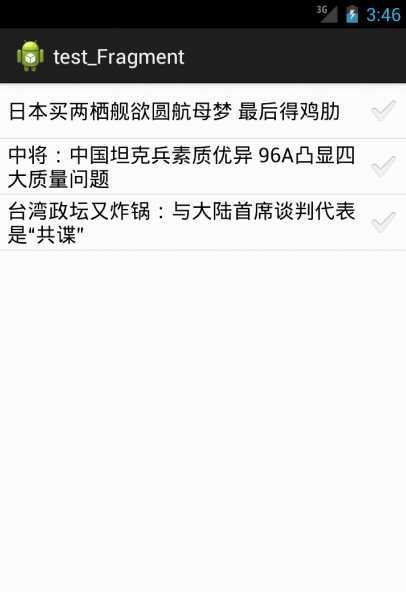 点击第二条新闻后,如下图:
点击第二条新闻后,如下图:
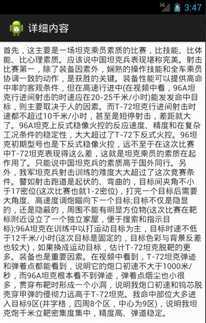
(横屏状态)
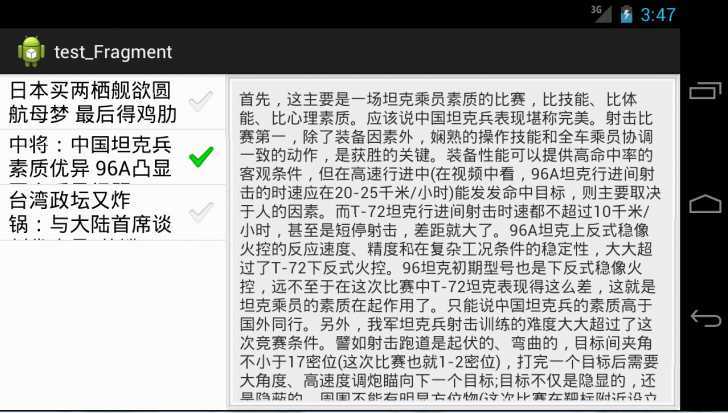
下面贴上代码:
先要创建两个布局文件,一个用于横屏、一个用于竖屏:

其代码分别为:
layout/main.xml:
<?xml version="1.0" encoding="utf-8"?> <LinearLayout xmlns:android="http://schemas.android.com/apk/res/android" android:layout_width="match_parent" android:layout_height="match_parent" android:orientation="horizontal" > <fragment class="com.topcsa.test_fragment.ListFragment" android:id="@+id/titles" android:layout_weight="1" android:layout_width="0px" android:layout_height="match_parent"/> </LinearLayout>
layout-land/main.xml:
<?xml version="1.0" encoding="utf-8"?> <LinearLayout xmlns:android="http://schemas.android.com/apk/res/android" android:layout_width="match_parent" android:layout_height="match_parent" android:orientation="horizontal" > <fragment class="com.topcsa.test_fragment.ListFragment" android:id="@+id/titles" android:layout_weight="1" android:layout_width="0px" android:layout_height="match_parent"/> <FrameLayout android:id="@+id/detail" android:layout_weight="2" android:layout_width="0px" android:layout_height="match_parent" android:background="?android:attr/detailsElementBackground"></FrameLayout> </LinearLayout>
包下的文件如下:
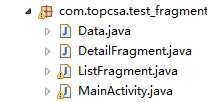
下面依次贴上代码(代码有详细注释):

package com.topcsa.test_fragment; public final class Data { public static final String[] titles = { "日本买两栖舰欲圆航母梦 最后得鸡肋", "中将:中国坦克兵素质优异 96A凸显四大质量问题", "台湾政坛又炸锅:与大陆首席谈判代表是“共谍”" }; public static final String[] DETAIL = { "日本防卫相小野寺五典8月4日在东京都发表演讲又一次强调了两栖攻击舰的重要性,指出日本将从美国购买黄蜂级两栖攻击舰。若发展顺利,新型两栖攻击舰将于2019年服役日本海上自卫队,成为其最大舰艇。", "首先,这主要是一场坦克乘员素质的比赛,比技能、比体能、比心理素质。应该说中国坦克兵表现堪称完美。射击比赛第一,除了装备因素外,娴熟的操作技能和全车乘员协调一致的动作,是获胜的关键。装备性能可以提供高命中率的客观条件,但在高速行进中(在视频中看,96A坦克行进间射击的时速应在20-25千米/小时)能发发命中目标,则主要取决于人的因素。而T-72坦克行进间射击时速都不超过10千米/小时,甚至是短停射击,差距就大了。96A坦克上反式稳像火控的反应速度、精度和在复杂工况条件的稳定性,大大超过了T-72下反式火控。96坦克初期型号也是下反式稳像火控,远不至于在这次比赛中T-72坦克表现得这么差,这就是坦克乘员的素质在起作用了。只能说中国坦克兵的素质高于国外同行。另外,我军坦克兵射击训练的难度大大超过了这次竞赛条件。譬如射击跑道是起伏的、弯曲的,目标间夹角不小于17密位(这次比赛也就1-2密位),打完一个目标后需要大角度、高速度调炮瞄向下一个目标;目标不仅是隐显的,还是隐蔽的,周围不能有明显方位物(这次比赛在靶标附近设立了一个独立家屋,便于搜索和指示目标);96A坦克在训练中以打运动目标为主,目标时速不低于12千米/小时(这次目标是固定的,目标色彩与背景反差也较大),如果换成运动目标,估计T-72坦克脱靶的更多。装备也是重要因素。在视频中看到,T-72坦克弹迹和弹着点都能看到,说明它的炮口初速不大于1000米/秒,而96A坦克根本看不到弹迹,弹着点烟尘也小很多,贯穿布靶时形成一个小洞,说明我炮口初速和钨芯脱壳穿甲弹的侵彻力远高于T-72坦克。我命中部位大多进入目标9区(井字格,四周8个区,中心为9区),说明我坦克炮千米立靶密集度集中,精度高、弹道稳定。", "两岸发展关系,台湾的政治稳定至关重要。台湾社会很多人或许没有意识到,台湾政治的一些深层无序已经相当严重。大陆与世界很多经济体谈自贸区或类似协定,但唯有同台湾的这一份冒出遭学生抗议并搁置的离奇周折,张显耀也是第一位被疑遭大陆“策反”的首席谈判代表。", }; }

package com.topcsa.test_fragment; import android.app.Fragment; import android.os.Bundle; import android.view.LayoutInflater; import android.view.View; import android.view.ViewGroup; import android.widget.ScrollView; import android.widget.TextView; public class DetailFragment extends Fragment { public static DetailFragment newInstance(int index){ DetailFragment f=new DetailFragment(); Bundle bundle=new Bundle(); bundle.putInt("index", index); f.setArguments(bundle);//将bundle对象作为Fragment的参数保存 return f; } public int getShownIndex(){ //获取要显示的列表项索引 return getArguments().getInt("index",0); } @Override public View onCreateView(LayoutInflater inflater, ViewGroup container, Bundle savedInstanceState) { if(container==null){ return null; } //创建一个滚动视图 ScrollView sl=new ScrollView(getActivity()); TextView text=new TextView(getActivity()); text.setPadding(10, 10, 10, 10); sl.addView(text); //设置文本框中要显示的文本 text.setText(Data.DETAIL[getShownIndex()]); return sl; } }

package com.topcsa.test_fragment; import android.app.Fragment; import android.app.FragmentTransaction; import android.content.Intent; import android.os.Bundle; import android.view.LayoutInflater; import android.view.View; import android.view.ViewGroup; import android.widget.ArrayAdapter; import android.widget.ListView; public class ListFragment extends android.app.ListFragment { boolean dualPane;// 是否在同一界面上显示列表和内容 int curCheckPosition = 0;// 当前选择的索引位置 @Override public void onActivityCreated(Bundle savedInstanceState) { super.onActivityCreated(savedInstanceState); //为列表设置适配器 setListAdapter(new ArrayAdapter<String>(getActivity(), android.R.layout.simple_list_item_checked, Data.titles)); //获取布局文件中添加的帧布局管理器 View detailFrame=getActivity().findViewById(R.id.detail); //判断是否在一屏上同时显示列表和详细内容 dualPane=detailFrame!=null&&detailFrame.getVisibility()==View.VISIBLE; if(savedInstanceState!=null){ //更新当前的索引位置 curCheckPosition=savedInstanceState.getInt("curChoice",0); } if(dualPane) { //设置列表为单选模式 getListView().setChoiceMode(ListView.CHOICE_MODE_SINGLE); showDetails(curCheckPosition);//显示详细内容 } } //该方法在STOP()之前执行,用于保存当前选中项的列表项的索引值 @Override public void onSaveInstanceState(Bundle outState) { // TODO Auto-generated method stub super.onSaveInstanceState(outState); outState.putInt("curChoice", curCheckPosition); } @Override public void onListItemClick(ListView l, View v, int position, long id) { // TODO Auto-generated method stub showDetails(position);//显示详细内容 } private void showDetails(int index) { curCheckPosition=index; if(dualPane){ getListView().setItemChecked(index, true);//设置选中状态 //获取用于显示详细信息的Fragment DetailFragment df=(DetailFragment) getFragmentManager().findFragmentById(R.id.detail); if(df==null||df.getShownIndex()!=index){ //创建一个新的DetailFragment实例,用于显示当前选项对应的详细内容 df=DetailFragment.newInstance(index); //在Activity中管理fragment,需要使用FragmentManager //获得一个FragmentTransaction实例 FragmentTransaction ft=getFragmentManager().beginTransaction(); //替换原来显示的详细内容 ft.replace(R.id.detail, df); //设置转换效果 ft.setTransition(FragmentTransaction.TRANSIT_FRAGMENT_FADE); ft.commit();//提交事务 } }else{ //竖屏 Intent intent=new Intent(getActivity(),MainActivity.DetailActivity.class); intent.putExtra("index", index); startActivity(intent); } } }

package com.topcsa.test_fragment; import android.app.Activity; import android.app.ActionBar; import android.app.Fragment; import android.app.FragmentManager; import android.app.FragmentTransaction; import android.content.res.Configuration; import android.os.Bundle; import android.view.LayoutInflater; import android.view.Menu; import android.view.MenuItem; import android.view.View; import android.view.ViewGroup; import android.os.Build; public class MainActivity extends Activity { @Override protected void onCreate(Bundle savedInstanceState) { super.onCreate(savedInstanceState); setContentView(R.layout.main); } public static class DetailActivity extends Activity { @Override protected void onCreate(Bundle savedInstanceState) { // TODO Auto-generated method stub super.onCreate(savedInstanceState); // 判断是否为横屏 if (getResources().getConfiguration().orientation == Configuration.ORIENTATION_LANDSCAPE) { finish(); return; } if (savedInstanceState == null) { //在初始化时,插入一个显示详细内容的Fragment //实例化DetailFragment对象 DetailFragment detail = new DetailFragment(); //设置传递的参数 detail.setArguments(getIntent().getExtras()); //添加一个显示详细内容的Fragment getFragmentManager().beginTransaction() .add(android.R.id.content, detail).commit(); } } } }
最后,别忘了清单文件的配置:(内部Activity的注册)
<activity android:name="com.topcsa.test_fragment.MainActivity$DetailActivity" android:label="详细内容"></activity>
新闻阅读Demo下载:http://download.csdn.net/detail/af74776/7806353
本文重点参考了的文章(基本上算是大汇总吧):http://blog.csdn.net/lilu_leo/article/details/7671533
http://www.cnblogs.com/mengdd/archive/2013/01/08/2851368.html
http://www.cnblogs.com/yydcdut/p/3921297.html
标签:android style blog http color os 使用 io strong
原文地址:http://www.cnblogs.com/scetopcsa/p/3930733.html